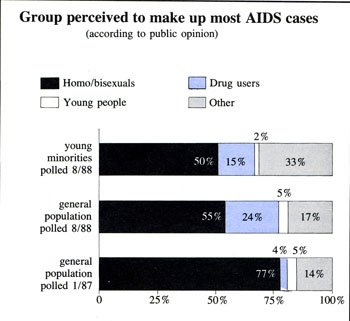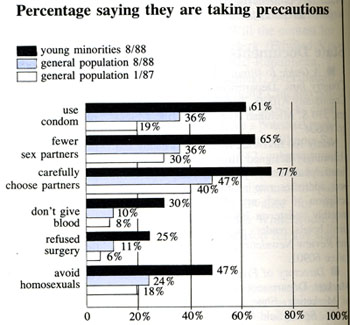 |
Home | Search | Browse | About IPO | Staff | Links |
 |
Home | Search | Browse | About IPO | Staff | Links |
|
The Pulse What Illinoisans think about AIDS 
By RICHARD DAY Richard Day Research recently conducted its third statewide survey of the public's awareness of and attitudes towards AIDS for the Illinois Department of Public Health. The other two studies were conducted in January and May of 1987. Most of the questions in this survey duplicated the January 1987 questionnaire in order to reveal any changes over time. As in the previous studies, a sample of 822 Illinois residents between the ages of 16 and 65 was interviewed. Since the findings from the 1987 surveys showed that young minorities were the least informed and most fearful of the disease, a separate, additional sample of 201 blacks and Hispanics between the ages of 16 and 25 was made in order to better understand the attitudes of this group. 
In general, data from the third survey on AIDS, conducted in July, show that in the past 18 months Illinois residents overall are now:
Young minorities are still less informed and more fearful of the disease than the general population. Downscale Hispanic men are the least informed and the least likely to practice safe sex. ("Downscale" is defined as having less than a high school education, being unemployed or employed as a laborer or a service worker and reporting an annual income of $15,000 or less.) One-third of the young blacks and Hispanics surveyed are afraid of getting the disease, compared to one-fifth of the general population (21 percent), up from January 1987 when 18 percent said they feared getting AIDS. In response to an "open-ended" question read to respondents without any answers from which to choose, at least half of both groups (the general public and young minorities) said that homo/bisexuals account for most of the AIDS cases today. The general population is now more likely to say that drug users are the biggest group (24 percent compared to 4 percent in early 1987). Among young minorities, 15 percent said that drug users are the biggest group, while 11 percent said November 1988 | Illinois Issues | 30  that whites make up most of the AIDS cases (compared to 1 percent overall). Half (47 percent) of the general public said that people can get AIDS by donating blood. In a later question, however, only 13 percent of these people said they have stopped giving blood for this reason. Those who were most likely to say they had stopped giving blood (ages 18 to 24, blacks, downscale) did not represent a blood donor profile. Only 10 percent of the general population said they have stopped giving blood due to the fear of getting the disease. Virtually all respondents know that AIDS can be spread by sexual contact and by sharing needles with those already infected. Responding to a series of "closed-ended" questions (in which choices are read to respondents and they choose among them), respondents are more likely to say they have taken precautions. Members of the general public who were most likely to say they are now practicing safe sex were:
A majority of young minorities said they are now practicing safer sex. Among them, more educated respondents (at least 13 years of school) are now more careful sexually. An above average number of unmarried respondents who said they have NOT taken any of these sex-related precautions were Hispanic men.□ Interviewing was conducted by professional interviewers calling during evenings and weekends between May 7 and July 16, 1988. All calls were made from a central location. When calling the Chicago metropolitan area, random digit dialing was used to include households with unlisted telephone numbers. In order to include those people who are seldom home, each number was called up to four times before it was discarded from the sample. All other proper survey research procedures were followed. The maximum margin of sampling error for the general population sample of 822 respondents is plus or minus 3 percent with a 95 percent chance of being correct. The margin of error for the sample of 201 nonwhite respondents is plus or minus 7 percent. Richard Day has his own survey research firm, Richard Day Research in Evanston. He holds a Ph.D. from the University of Illinois in Urbana-Champaign. November 1988 | Illinois Issues | 31 |
|
|